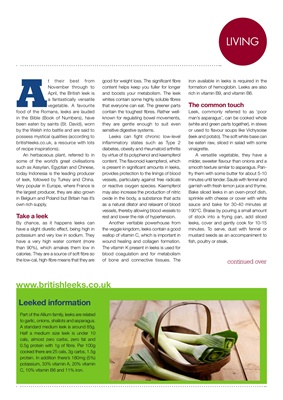
LIVING
continued over
Part of the Allium family, leeks are related
to garlic, onions, shallots and asparagus.
A standard medium leek is around 85g.
Half a medium size leek is under 10
cals, almost zero carbs, zero fat and
0.5g protein with 1g of fibre. Per 100g
cooked there are 25 cals, 3g carbs, 1.5g
protein. In addition there's 180mg (5%)
potassium, 33% vitamin A, 20% vitamin
C, 10% vitamin B6 and 11% iron.
Leeked information
A
t their best from
November through to
April, the British leek is
a fantastically versatile
vegetable. A favourite
food of the Romans, leeks are lauded
in the Bible (Book of Numbers), have
been eaten by saints (St. David), worn
by the Welsh into battle and are said to
possess mystical qualities (according to
britishleeks.co.uk, a resource with lots
of recipe inspirations).
An herbaceous plant, referred to in
some of the world's great civilisations
such as Assyrian, Egyptian and Chinese,
today Indonesia is the leading producer
of leek, followed by Turkey and China.
Very popular in Europe, where France is
the largest producer, they are also grown
in Belgium and Poland but Britain has it's
own rich supply.
Take a leek
By chance, as it happens leeks can
have a slight diuretic effect, being high in
potassium and very low in sodium. They
have a very high water content (more
than 90%), which also makes them low
in calories. They and are a source of soft
fibre so the low-cal, high-fibre means
that they are good for weight loss. The
significant fibre content helps you fuller
for longer and boosts your metabolism.
The leek whites contain some highly
soluble fibres that everyone can eat. The
greener parts contain the toughest fibres.
Rather well-known for regulating bowel
movements, they are gentle enough to
suit even sensitive digestive systems.
Leeks can fight chronic low-level
inflammatory states such as Type 2
diabetes, obesity and rheumatoid arthritis
by virtue of its polyphenol and kaempferol
content. The flavonoid kaempferol, which
is present in significant amounts in leeks,
provides protection to the linings of blood
vessels, particularly against free radicals
or reactive oxygen species. Kaempferol
may also increase the production of nitric
oxide in the body, a substance that acts
as a natural dilator and relaxant of blood
vessels, thereby allowing blood vessels to
rest and lower the risk of hypertension.
Another veritable powerhouse from
the veggie kingdom, leeks contain a good
wallop of vitamin C, which is important in
wound healing and collagen formation.
The vitamin K present in leeks is used for
blood coagulation and for metabolism
of bone and connective tissues. The
iron available in leeks is required in the
formation of hemoglobin. Leeks are also
rich in vitamin B9, and vitamin B6.
The common touch
Leek, commonly referred to as 'poor
man's asparagus', can be cooked whole
(white and green together), in stews or
use to flavour soups like Vichycoise (leek
and potato). The soft white base can
be eaten raw, sliced in salad with some
viniagrette.
A versatile vegetable, they have a
milder, sweeter flavour than onions and a
smooth texture similar to asparagus. Panfry them with some butter for about 5-10
minutes until tender. Sauté with fennel and
garnish with fresh lemon juice and thyme.
Bake sliced leeks in an oven-proof dish,
sprinkle with cheese or cover with white
sauce and bake for 30-40 minutes at
190°C. Braise by pouring a small amount
of stock into a frying pan, add sliced
leeks, cover and gently cook for 10-15
minutes. To serve, dust with fennel or
mustard seeds as an accompaniment to
fish, poultry or steak.
www.britishleeks.co.uk